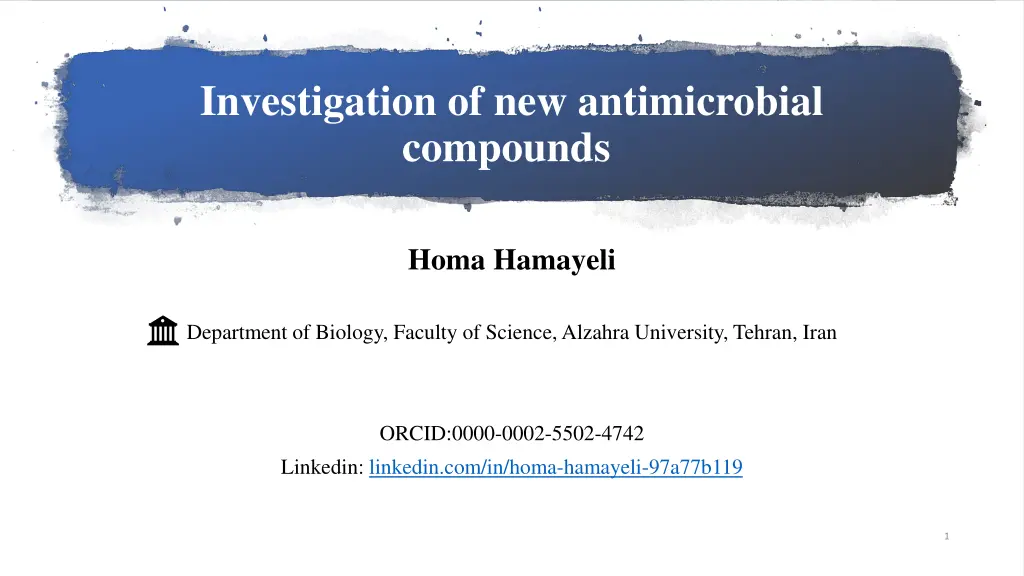
Novel Antimicrobial Compounds: Investigating Terrestrial and Aquatic Sources
Delve into the research by Homa Hamayeli from Alzahra University on identifying new antimicrobial compounds from terrestrial and aquatic ecosystems. The study emphasizes the importance of combating drug-resistant microorganisms through innovative solutions. Detailed methods and results showcase potential sources like Bryophyllum pinnatum and Stichodactyla haddoni sea anemone with antimicrobial activity against various pathogens.
Download Presentation

Please find below an Image/Link to download the presentation.
The content on the website is provided AS IS for your information and personal use only. It may not be sold, licensed, or shared on other websites without obtaining consent from the author. If you encounter any issues during the download, it is possible that the publisher has removed the file from their server.
You are allowed to download the files provided on this website for personal or commercial use, subject to the condition that they are used lawfully. All files are the property of their respective owners.
The content on the website is provided AS IS for your information and personal use only. It may not be sold, licensed, or shared on other websites without obtaining consent from the author.
E N D
Presentation Transcript
Investigation of new antimicrobial compounds Homa Hamayeli Department of Biology, Faculty of Science, Alzahra University, Tehran, Iran ORCID:0000-0002-5502-4742 Linkedin: linkedin.com/in/homa-hamayeli-97a77b119 1
Abstract: The importance of diagnosing and treating infectious diseases is well known, but despite the improvement in health conditions, there are still reports of deaths due to infectious diseases. These diseases can be treated with antimicrobial drugs, however, due to the increased resistance of pathogenic microorganisms to drugs, there is a need to identify new sources and compounds with antimicrobial activity. 2
Introduction: 3 Drug resistance of microorganisms leads to prolonged hospital stay and treatment failure. Research has been done on new antimicrobial compounds of natural origin. Microbiological tests of disk diffusion, minimum inhibitory concentration (MIC) and minimum bactericidal concentration (MBC) are performed according to standard protocols. In the continuation of the process, there is a need for other studies in other fields, such as chemical analysis.
Methods: The Clinical & Laboratory Standards Institute (CLSI) 4 Disk-diffusion agar method: M02: Performance Standards for Antimicrobial Disk Susceptibility Tests, 13th Edition (CLSI, 2018b). Microdilution and macrodilution methods : M07: Methods for Dilution Antimicrobial Susceptibility Tests for Bacteria That Grow Aerobically, 11th Edition (CLSI, 2018a).
Methods: 5 Figure 1: Disk diffusion method. Photo by Homa Hamayeli, Shahid Bahonar University of Kerman, Iran, 2016.
Results: Some sources with antimicrobial effect from terrestrial and aquatic ecosystems are 6 listed in Tables 1 and 2. Table 1: Terrestrial ecosystem. Source Antimicrobial activity Escherichia coli Ref Bryophyllum pinnatum (Nugraha et al., 2020) Moringa oleifera (Nugraha et al., 2020) Klebsiella pneumoniae Hibiscus tiliaceus (Nugraha et al., 2020) Staphylococcus aureus Lunasia amara (Nugraha et al., 2020) Pseudomonas aeruginosa
Results: Table 2: Aquatic ecosystem. 7 Source Antimicrobial activity P. aeruginosa, Acinetobacter baumannii, Bacillus cereus, K. pneumonia, E. coli, S. aureus S. aureus, A. baumannii Ref Stichodactyla haddoni sea anemone (Hamayeli, Hassanshahian, & Hesni, 2019) Dysidea sp. sponge (Hamayeli, Hasanshahian, Namaki Shoshtari, & Askari Hesni, 2017) Calcined marine coral S. aureus, E. coli (Kambiz Sadeghi, Sarinthip Thanakkasaranee, I-Jong Lim, & Seo, 2020) Fascaplysinopsis reticulate sponge Vibrio natriegens, (Campos et al., 2019) Vibrio carchariae
Discussion: 8 With increasing drug resistance of pathogenic organisms, it is necessary to explore and identify new compounds. There are reports of antimicrobial compounds originating from aquatic and terrestrial ecosystems that can be promising. These compounds can have antimicrobial and antifungal (Hamayeli, Shoshtari, Hassanshahian, & Askari, 2016) properties.
References: Campos, P.-E., Pichon, E., Moriou, C., Clerc, P., Tr pos, R., Frederich, M., . . . Al-Mourabit, A. (2019). New antimalarial and antimicrobial tryptamine derivatives from the marine sponge Fascaplysinopsis reticulata. Marine drugs, 17(3), 167. CLSI. (2018a). Methods for Dilution Antimicrobial Susceptibility Tests for Bacteria That Grow Aerobically. 11 th ed. CLSI standard M07. Wayne, PA: Clinical and Laboratory Standards Institute. CLSI. (2018b). Performance Standards for Antimicrobial Disk Susceptibility Tests. 13th ed. CLSI standard M02. Wayne, PA: Clinical and Laboratory Standards Institute. Hamayeli, H., Hasanshahian, M., Namaki Shoshtari, A., & Askari Hesni, M. (2017). Study the antimicrobial effect of three marine sponges (Dysidea sp.) collected at Persian Gulf on some pathogenic bacteria in planktonic and biofilm forms. Iranian Journal of Medical Microbiology, 11(4), 45-56. Hamayeli, H., Hassanshahian, M., & Hesni, M. A. (2019). The antibacterial and antibiofilm activity of sea anemone (Stichodactyla haddoni) against antibiotic-resistant bacteria and characterization of bioactive metabolites. International Aquatic Research, 11(1), 85-97. Hamayeli, H., Shoshtari, A., Hassanshahian, M., & Askari, M. (2016). Study the antimicrobial activity of six marine sponges and three parts of sea anemone on Candida albicans. Journal Coastal Life Medicine, 4(8), 122-129. Kambiz Sadeghi, Sarinthip Thanakkasaranee, I-Jong Lim, & Seo, J. (2020). Calcined marine coral powders as a novel ecofriendly antimicrobial agent. Materials doi:https://doi.org/10.1016/j.msec.2019.110193 Nugraha, A. S., Permatasari, A. E. N., Kadarwenny, C. P., Pratoko, D. K., Triatmoko, B., Rosyidi, V. A., . . . Sary, I. P. (2020). Phytochemical Screening and the Antimicrobial and Antioxidant Activities of Medicinal Plants of Meru Betiri National Park Indonesia. Journal of Herbs, Spices & Medicinal Plants, 1-12. 107. Science and Engineering: C, 9
CC BY-NC 4.0 10
